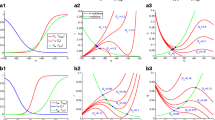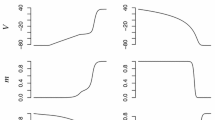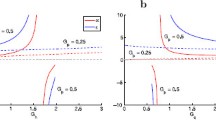Abstract
Models of electrical activity in excitable cells involve nonlinear interactions between many ionic currents. Changing parameters in these models can produce a variety of activity patterns with sometimes unexpected effects. Further more, introducing new currents will have different effects depending on the initial parameter set. In this study we combined global sampling of parameter space and local analysis of representative parameter sets in a pituitary cell model to understand the effects of adding K + conductances, which mediate some effects of hormone action on these cells. Global sampling ensured that the effects of introducing K + conductances were captured across a wide variety of contexts of model parameters. For each type of K + conductance we determined the types of behavioral transition that it evoked. Some transitions were counterintuitive, and may have been missed without the use of global sampling. In general, the wide range of transitions that occurred when the same current was applied to the model cell at different locations in parameter space highlight the challenge of making accurate model predictions in light of cell-to-cell heterogeneity. Finally, we used bifurcation analysis and fast/slow analysis to investigate why specific transitions occur in representative individual models. This approach relies on the use of a graphics processing unit (GPU) to quickly map parameter space to model behavior and identify parameter sets for further analysis. Acceleration with modern low-cost GPUs is particularly well suited to exploring the moderate-sized (5-20) parameter spaces of excitable cell and signaling models.









Similar content being viewed by others
References
Barrio, R., & Shilnikov, A. (2011). Parameter-sweeping techniques for temporal dynamics of neuronal systems: Case study of hindmarsh-rose model. The Journal of Mathematical Neuroscience, 1(1), 6.
Barrio, R., Rodríguez, M., Serrano, S., & Shilnikov, A. (2015). Mechanism of quasi-periodic lag jitter in bursting rhythms by a neuronal network. EPL (Europhysics Letters), 112(3), 38,002.
Brette, R., & Goodman, D.F.M. (2012). Simulating spiking neural networks on GPU. Network: Computation in Neural Systems, 23(4), 167–182.
Calin-Jageman, R.J., Tunstall, M.J., Mensh, B.D., Katz, P.S., & Frost, W.N. (2007). Parameter space analysis suggests multi-site plasticity contributes to motor pattern initiation in tritonia. Journal of Neurophysiology, 98(4), 2382–2398.
Caplan, J.S., Williams, A.H., & Marder, E. (2014). Many parameter sets in a multicompartment model oscillator are robust to temperature perturbations. The Journal of Neuroscience, 34(14), 4963–4975.
DeWoskin, D., Geng, W., Stinchcombe, A.R., & Forger, D.B. (2014). It is not the parts, but how they interact that determines the behaviour of circadian rhythms across scales and organisms. Interface focus, 4(3), 20130,076.
Dhooge, A., Govaerts, W., & Kuznetsov, Y.A. (2003). MATCONT: A Matlab package for numerical bifurcation analysis of ODEs. ACM Transactions on Mathematical Software (TOMS), 29(2), 141–164.
Doedel, E., & Kernevez, J.P. (1986). AUTO, Software For Continuation And Bifurcation Problems In Ordinary Differential Equations. California Institute of Technology.
Doloc-Mihu, A., & Calabrese, R.L. (2011). A database of computational models of a half-center oscillator for analyzing how neuronal parameters influence network activity. Journal of Biological Physics, 37(3), 263–283.
Ermentrout, B. (2002). Simulating analyzing And Animating Dynamical Systems. SIAM: A Guide To XPPAUT For Researchers And Students.
Fakler, B., & Adelman, J.P. (2008). Control of KCa channels by calcium nano/microdomains. Neuron, 59 (6), 873–881.
Foster, W.R., Ungar, L.H., & Schwaber, J.S. (1993). Significance of conductances in Hodgkin-Huxley models. Journal of Neurophysiology, 70(6), 2502–2518.
Goldman, M.S., Golowasch, J., Marder, E., & Abbott, L.F. (2001). Global structure, robustness, and modulation of neuronal models. The Journal of Neuroscience, 21(14), 5229–5238.
Günay, C. (2014). Neuronal model databases. In Jaeger, D, & Jung, R (Eds.) Encyclopedia of Computational Neuroscience (pp. 1–6). New York: Springer.
Günay, C., Edgerton, J.R., & Jaeger, D. (2008). Channel density distributions explain spiking variability in the globus pallidus: a combined physiology and computer simulation database approach. The Journal of Neuroscience, 28(30), 7476–7491.
Hindmarsh, J., & Rose, R. (1984). A model of neuronal bursting using three coupled first order differential equations. Proceedings of the Royal Society of London B: Biological Sciences, 221(1222), 87–102.
Iooss, B., & Lemaître, P (2015). A review on global sensitivity analysis methods. In Dellino, G, & Meloni, C (Eds.) Uncertainty management in simulation-optimization of complex systems operations research/computer science interfaces series, (Vol. 59 pp. 101–122). US: springer.
Kispersky, T.J., Caplan, J.S., & Marder, E. (2012). Increase in sodium conductance decreases firing rate and gain in model neurons. The Journal of Neuroscience, 32(32), 10,995–11,004.
Linaro, D., Champneys, A., Desroches, M., & Storace, M. (2012). Codimension-two homoclinic bifurcations underlying spike adding in the Hindmarsh–Rose burster. SIAM Journal on Applied Dynamical Systems, 11(3), 939–962.
Marin, B., Barnett, W.H., Doloc-Mihu, A., Calabrese, R.L., & Cymbalyuk, G.S. (2013). High prevalence of multistability of rest states and bursting in a database of a model neuron. PLoS Computational Biology, 9(3), e1002,930.
McKay, M.D., Beckman, R.J., & Conover, W.J. (1979). A comparison of three methods for selecting values of input variables in the analysis of output from a computer code. Technometrics, 21(2), 239–245.
Osinga, H., & Tsaneva-Atanasova, K. (2010). Dynamics of plateau bursting depending on the location of its equilibrium. Journal of Neuroendocrinology, 22(12), 1301–1314.
Osinga, H.M., Sherman, A., & Tsaneva-Atanasova, K. (2012). Cross-currents between biology and mathematics: The codimension of pseudo-plateau bursting. Discrete and Continuous Dynamical Systems Series A, 32(8), 2853–2877.
Prinz, A.A., Billimoria, C.P., & Marder, E. (2003). Alternative to hand-tuning conductance-based models: Construction and analysis of databases of model neurons. Journal of Neurophysiology, 90(6), 3998–4015.
Prinz, A.A., Bucher, D., & Marder, E. (2004). Similar network activity from disparate circuit parameters. Nature Neuroscience, 7(12), 1345–1352.
Rinzel, J., & Ermentrout, G.B. (1998). Analysis of neural excitability and oscillations. Methods in Neuronal Modeling, 2, 251–292.
Rodríguez, M., Blesa, F., & Barrio, R. (2015). OpenCL parallel inte gration of ordinary differential equations: Applications in computational dynamics. Computer Physics Communications, 192, 228–236.
Sherman, A. (2011). Dynamical systems theory in physiology. The Journal of General Physiology, 138(1), 13–19.
Sherman, A., Keizer, J., & Rinzel, J. (1990). Domain model for Ca 2+-inactivation of Ca 2+ channels at low channel density. Biophysical Journal, 58(4), 985–995.
Stern, J.V., Osinga, H.M., LeBeau, A., & Sherman, A. (2008). Resetting behavior in a model of bursting in secretory pituitary cells: Distinguishing plateaus from pseudo-plateaus. Bulletin of Mathematical Biology, 70(1), 68–88.
Stojilković, S.S., Tabak, J., & Bertram, R. (2010). Ion channels and signaling in the pituitary gland. Endocrine Reviews, 31(6), 845–915.
Storace, M., Linaro, D., & de Lange, E. (2008). The Hindmarsh-Rose neuron model: Bifurcation analysis and piecewise-linear approximations. Chaos: An Interdisciplinary Journal of Nonlinear Science, 18(3), 033128.
Tabak, J., Toporikova, N., Freeman, M.E., & Bertram, R. (2007). Low dose of dopamine may stimulate prolactin secretion by increasing fast potassium currents. Journal of Computational Neuroscience, 22(2), 211–222.
Tabak, J., Tomaiuolo, M., Gonzalez-Iglesias, A.E., Milescu, L.S., & Bertram, R. (2011). Fast-activating voltage- and calcium-dependent potassium (BK) conductance promotes bursting in pituitary cells: a dynamic clamp study. The Journal of Neuroscience, 31(46), 16,855–16,863.
Taylor, A.L., Goaillard, J.M., & Marder, E. (2009). How multiple conductances determine electrophysiological properties in a multicompartment model. The Journal of Neuroscience, 29(17), 5573–5586.
Teka, W., Tabak J., Vo, T., Wechselberger, M., & Bertram, R. (2011a). The dynamics underlying pseudo-plateau bursting in a pituitary cell model. The Journal of Mathematical Neuroscience, 1(1), 1–23.
Teka, W., Tsaneva-Atanasova, K., Bertram, R., & Tabak, J. (2011b). From plateau to pseudo-plateau bursting: Making the transition. Bulletin of Mathematical Biology, 73(6), 1292–1311.
Terman, D. (1992). The transition from bursting to continuous spiking in excitable membrane models. Journal of Nonlinear Science, 2(2), 135–182.
Toporikova, N., Tabak, J., Freeman, M.E., & Bertram, R. (2008). A-type K + current can act as a trigger for bursting in the absence of a slow variable. Neural Computation, 20(2), 436–451.
Tsaneva-Atanasova, K., Osinga, H.M., Rieß, T., & Sherman, A. (2010). Full system bifurcation analysis of endocrine bursting models. Journal of Theoretical Biology, 264(4), 1133–1146.
Van Goor, F., Zivadinovic, D., Martinez-Fuentes, A.J., & Stojilkovic, S.S. (2001). Dependence of pituitary hormone secretion on the pattern of spontaneus voltage-gated calcium influx: Cell type-specific action potential secretion coupling. Journal of Biological Chemistry, 276(36), 33,840–33,846.
Vo, T., Bertram, R., Tabak, J., & Wechselberger, M. (2010). Mixed mode oscillations as a mechanism for pseudo-plateau bursting. Journal of Computational Neuroscience, 28(3), 443–458.
Vo, T., Bertram, R., & Wechselberger, M. (2013). Multiple geometric viewpoints of mixed mode dynamics associated with pseudo-plateau bursting. SIAM Journal on Applied Dynamical Systems, 12(2), 789–830.
Vo, T., Tabak, J., Bertram, R., & Wechselberger, M. (2014). A geometric understanding of how fast activating potassium channels promote bursting in pituitary cells. Journal of Computational Neuroscience, 36(2), 259–278.
Williams, A.H., Kwiatkowski, M.A., Mortimer, A.L., Marder, E., Zeeman, M.L., & Dickinson, P.S. (2013). Animal-to-animal variability in the phasing of the crustacean cardiac motor pattern: an experimental and computational analysis. Journal of Neurophysiology, 109(10), 2451–2465.
Acknowledgments
This work was supported by grant DMS1220063 from the National Science Foundation.
Author information
Authors and Affiliations
Corresponding author
Ethics declarations
Conflict of interests
The authors declare that they have no conflict of interest.
Additional information
Action Editor: Bard Ermentrout
Rights and permissions
About this article
Cite this article
Fletcher, P., Bertram, R. & Tabak, J. From global to local: exploring the relationship between parameters and behaviors in models of electrical excitability. J Comput Neurosci 40, 331–345 (2016). https://doi.org/10.1007/s10827-016-0600-1
Received:
Revised:
Accepted:
Published:
Issue Date:
DOI: https://doi.org/10.1007/s10827-016-0600-1




